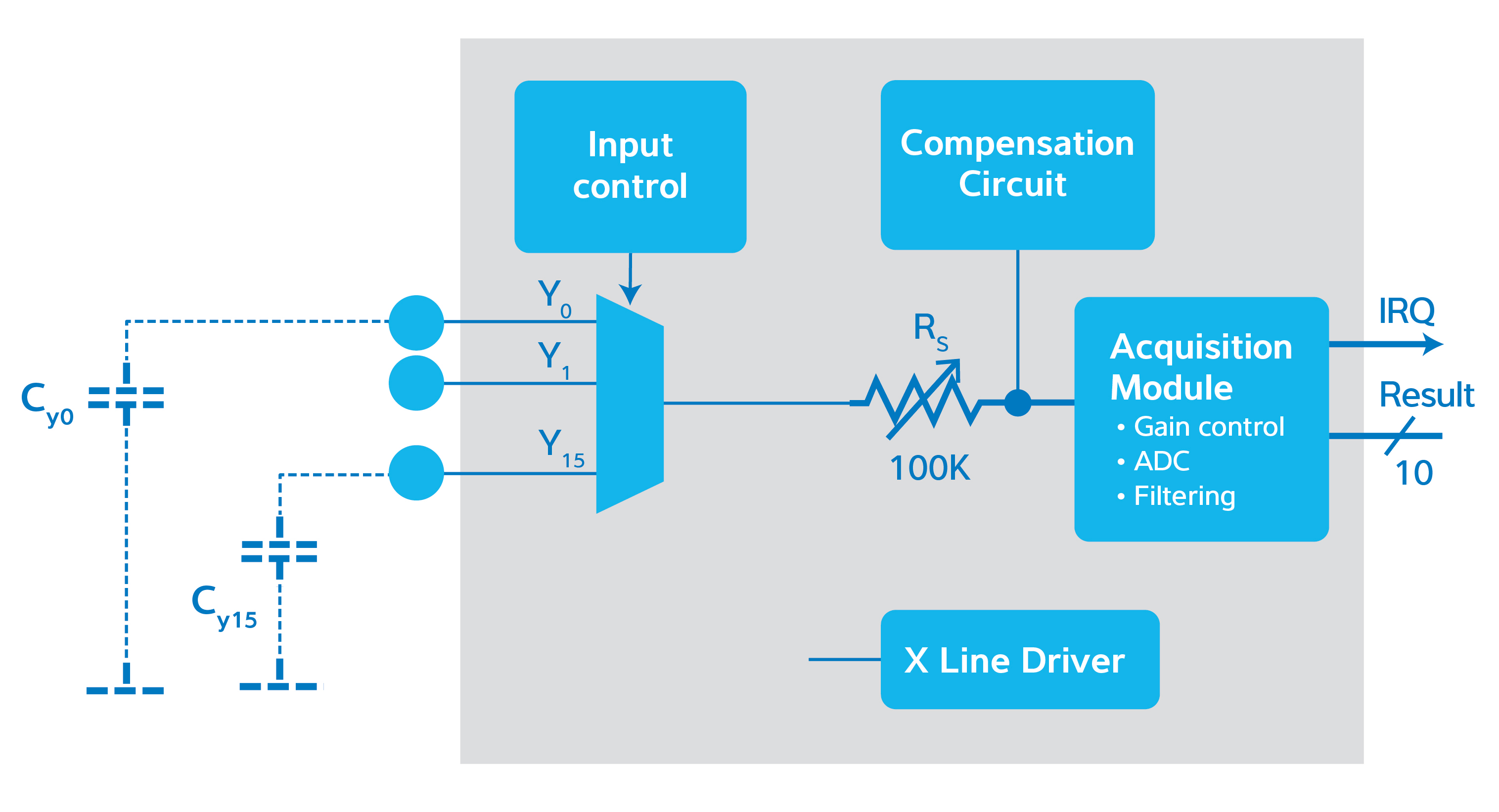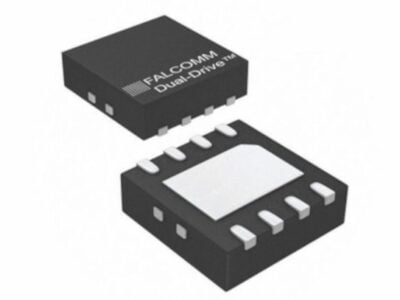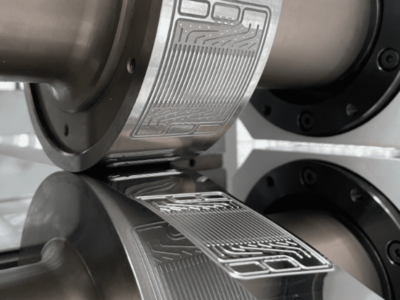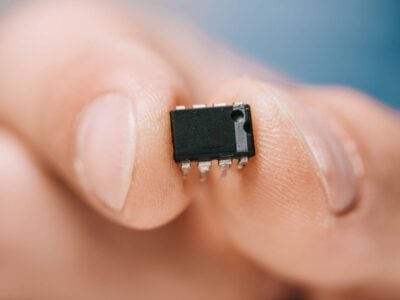
Capacitive, intuitive: New design options for automotive HMIs
Center stack touchscreens in the dash are becoming more common; invisible touch buttons are replacing mechanical buttons; and touchpads are bringing new functions to rotary knobs (see figure 1). Electronic pedals can even open trunks with the approach of the owner’s foot, and doors can unlock without any action from the driver. This last function is one of the toughest to implement. The door handle detection system needs to be miniaturized, consume almost no power, be fully reliable and immune to all disturbances, and be transparent to the user. For all these reasons, capacitive detection in door handle applications is more and more a field requiring research and innovation.

Figure 1 shows some of the many applications of capacitive touch and sensing in automobiles. Atmel® has extensive expertise in capacitive sensing in all of these areas, including door handles. In this particular application, patented Atmel charge transfer technology coupled with Atmel automotive microcontrollers (MCUs) has already resulted in many successful applications of the first generation of Atmel QTouch® software library solutions.
Atmel is now bringing to the market a new generation of capacitive touch solutions, based on a combined hardware and software approach. The combination of a hardware Peripheral Touch Controller (PTC) and a high-level full-featured software library (the QTouch library) is bringing capacitive touch performance to a new level. Applied in the door handle domain, it can fulfill the most demanding requirements.
Introduction to the door handle capacitive detection
The door handle is part of a Passive Entry/Passive Start system. This complex system is mixing LF (e.g. an ATA5291 LF antenna driver and an ATA5702 key fob controller) and HF (e.g. an ATA5831 HF transceiver) communications, data encryption (e.g. AES), securitized protocols (e.g. Atmel Open Immobilizer Protocol), and algorithms for geo-localization. All these complex functions consume power and need to be activated when the driver is ready to open the door (see figure 2). The capacitive detection in the door handle module is a key feature of the system. In order to detect the hand just before the driver is pulling the door handle, the touch system has to detect the palm and wake up the whole system in advance to allow enough time for a complete secure communication and authentication . In other words, this all has to happen effectively before the driver pulls the door handle so that it opens as if it was never locked. As the driver leaves the car, a similar function locks the door, usually with a specific gesture on the door handle (a simple touch with the thumb for instance).

There are several technical challenges to overcome to achieve best-in-class capacitive detection in a door handle detection system. The most relevant being that the system must:
- Achieve a proper detection distance to allow sufficient time for the system to wake up and perform its authentication tasks. The typical distance for unlock detection is between 1 and 4 cm.
- Consume as little power as possible. The capacitive detection is the only function that must always be awake, as it is responsible for the initiation of the whole unlock process. Typical average power consumption is in the range of 50-100µA.
- Be reactive enough to provide a transparent user experience. The driver should never encounter a locked door due to the fact that the unlock system was not woken up sufficiently in advance. The typical response time is 20ms.
- Be fully reliable in disturbed conditions. The capacitive detection has to detect the driver hand in disturbed conditions (rain, interference, etc.) while rejecting all the unwanted touch signals potentially induced by these disturbances.
Atmel technical proposal
In addition to proximity capacitive detection, a door handle system must provide communication with the PEPS microcontroller (MCU), including serial communication, power line communication, LIN, CAN, etc., and provide support for additional wireless interface (NFC, etc.). It must also perform application-specific tasks. These various system requirements lead to the need of MCUs with very different packages, memory sizes and communication interfaces.
In answer to all the door handle challenges, Atmel has developed an innovative hardware PTC module coupled with the QTouch software library to deliver best-in-class capacitive touch performance (see figure 3). Thanks to this combined hardware and software solution, Atmel can deliver a high- performance hardware capacitive acquisition system with a small footprint library, fully configurable by software. The solution also requires very limited CPU usage and thus very low power consumption.

In answer to the various system requirements, Atmel has integrated this hardware PTC module and software library in a large number of automotive-qualified microcontrollers. This provides a unique single-chip solution that answers both the capacitive proximity detection function and the other communication and application tasks.
Figure 4 shows two examples of door handle systems with different system requirements. Both can be fulfilled with a single Atmel MCU embedding the same PTC and QTouch library, but with different processor cores, package sizes, memory footprints and communication interfaces.

Technical introduction to Atmel PTC and QTouch library
Figure 5 shows the main functions inside the PTC hardware module.

- Input control: this module multiplexes the multiple sensor channels inputs. In mutual-capacitance mode, both X (driving signals) and Y (receiving signals) are used. In self-capacitance mode, only Y (drive/receive signals) are used. It should be noted that the PTC is able to manage both self-capacitance and mutual capacitance in the same application.
- Compensation circuit: This circuit selects the compensation capacitor to compensate for the sensing capacitor (calibration feature). It also selects the value of the internal serial resistor.
- Acquisition module: this module manages the complete acquisition process. Its main tasks include:
- Charge transfer operation
- Signal amplification
- ADC conversion
- Oversampling management
- Output results for post-processing
Focus on low level PTC and QTouch library features
The complete description of the hardware and software features of the PTC and QTouch library are described in the technical documentation given at the end of this article. We will now examine a selection of the low-level features of the PTC, which are relevant in the case of a typical door handle capacitive proximity detection.
- Timings considerations
Many parameters have to be considered to define the timings of a door handle proximity detection system. These include:
- The sensor capacitor value
- The serial resistor value (internal and external)
- The clock of the hardware PTC module for signal acquisition (PTC_CLK)
- The Charge Share Delay parameter of the PTC (CSD)
- The clock of the CPU for signal processing (CPU_CLK)
The sensor capacitor value is dependent on the sensor size, the layout parasitic capacitance, and the optional shield layer. This capacitor is automatically compensated by the internal compensation circuit of the PTC and has to fit within its compensation range.
The serial resistor can be internal and, optionally, external.
The main considerations are:
- Large sensor capacitor generally leads to better proximity detection
- Large serial resistor leads to a better low-frequency noise filtering
- Large capacitor and resistor lead to a larger charge time constant, which will increase the response time and power consumption.
The flexible clocks options are useful for finding the best trade-off between detection performance and power consumption.
The PTC_clock is used to perform the charge transfer sequence and the ADC conversion. It has to be slow enough to ensure a full charge transfer operation, and fast enough to minimize ADC conversion time. To find the best balance in between, the Charge Share Delay (CSD) setting can also be used. This CSD adds additional cycles delay during the charge transfer sequence, but not during the ADC sequence. It allows the selection of a faster PTC_CLK to speed up the ADC conversion, while slowing down the charge transfer process according to the charge time constant of the system.
The CPU_CLK is used to post process the data output by the PTC. It is a digital process managed by the CPU of the micro. The selection of the CPU_CLK may depend on the maximum peak current specification and maximum average current specification. A high CPU_CLK decreases the average current consumption but increases the peak current consumption.
Gain and oversampling considerations
The PTC module embeds a gain stage and an oversampling/filtering feature. Increasing the gain stage leads to an increase of not only the signal amplitude but also the noise level. Increasing the number of samples allows the design to average the signal and increase the SNR, but also to increase the acquisition time.
The table 1 shows the resulting signal values depending on the filter_level (i.e., the number of acquired samples, from 1 to 64) and the gain values (i.e., the amplification, from 1 to 32). The resulting signal values are a combination of averaging and amplification of the signal in order to give the best sensitivity and SNR trade off.

In a door handle system, it may be of interest to increase the gain settings to improve the capacitive detection distance, and to increase the filter level to improve the stability and reliability of the signal under all conditions. On top of these considerations, the filter level also has to be minimized to keep the power consumption as low as possible.
Conclusion
Capacitive detection in a door handle system is a very demanding design challenge. To overcome this challenge, Atmel has introduced a new family of automotive MCUs that embed an innovative Peripheral Touch Controller hardware module and QTouch software library. This solution delivers best-in-class capacitive detection performances and full flexibility in the selection of the best-suited MCU.
References:
Atmel-42195-QTouch-Library-Peripheral-Touch-Controller_User-Guide
Atmel-42441-Low-Power-Sensor-Design-with-PTC_ApplicationNote_AT12405
About the author:
Gilles Robert is Senior Field Application Engineer at Atmel. He specializes in Automotive Touch Solutions.
 If you enjoyed this article, you will like the following ones: don't miss them by subscribing to :
eeNews on Google News
If you enjoyed this article, you will like the following ones: don't miss them by subscribing to :
eeNews on Google News




